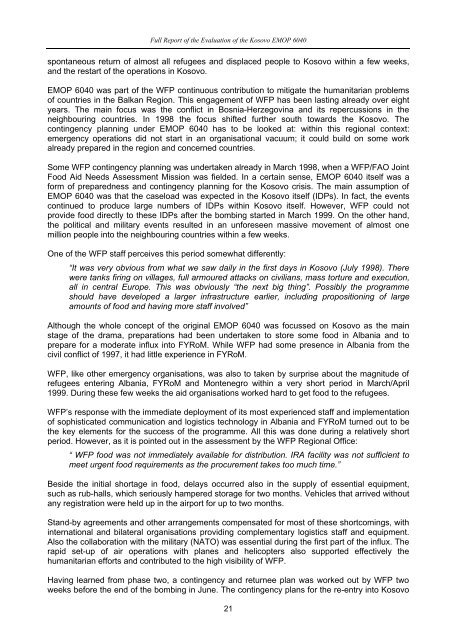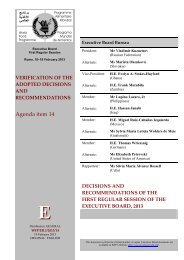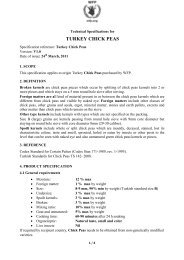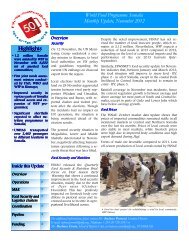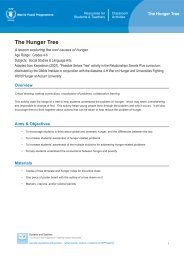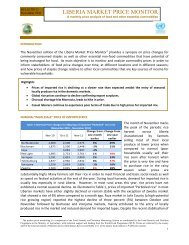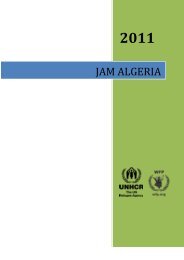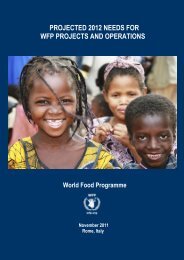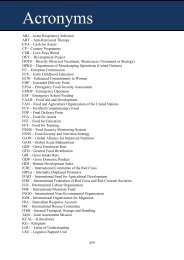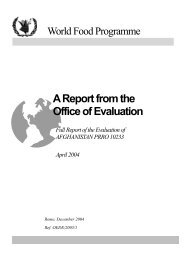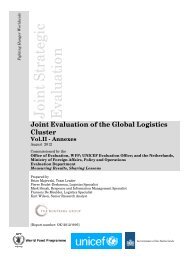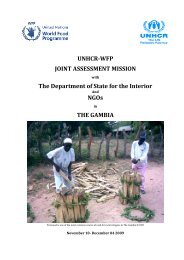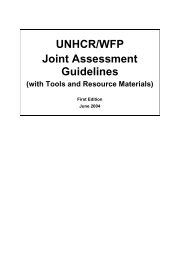Full Report - WFP Remote Access Secure Services
Full Report - WFP Remote Access Secure Services
Full Report - WFP Remote Access Secure Services
You also want an ePaper? Increase the reach of your titles
YUMPU automatically turns print PDFs into web optimized ePapers that Google loves.
<strong>Full</strong> <strong>Report</strong> of the Evaluation of the Kosovo EMOP 6040<br />
spontaneous return of almost all refugees and displaced people to Kosovo within a few weeks,<br />
and the restart of the operations in Kosovo.<br />
EMOP 6040 was part of the <strong>WFP</strong> continuous contribution to mitigate the humanitarian problems<br />
of countries in the Balkan Region. This engagement of <strong>WFP</strong> has been lasting already over eight<br />
years. The main focus was the conflict in Bosnia-Herzegovina and its repercussions in the<br />
neighbouring countries. In 1998 the focus shifted further south towards the Kosovo. The<br />
contingency planning under EMOP 6040 has to be looked at: within this regional context:<br />
emergency operations did not start in an organisational vacuum; it could build on some work<br />
already prepared in the region and concerned countries.<br />
Some <strong>WFP</strong> contingency planning was undertaken already in March 1998, when a <strong>WFP</strong>/FAO Joint<br />
Food Aid Needs Assessment Mission was fielded. In a certain sense, EMOP 6040 itself was a<br />
form of preparedness and contingency planning for the Kosovo crisis. The main assumption of<br />
EMOP 6040 was that the caseload was expected in the Kosovo itself (IDPs). In fact, the events<br />
continued to produce large numbers of IDPs within Kosovo itself. However, <strong>WFP</strong> could not<br />
provide food directly to these IDPs after the bombing started in March 1999. On the other hand,<br />
the political and military events resulted in an unforeseen massive movement of almost one<br />
million people into the neighbouring countries within a few weeks.<br />
One of the <strong>WFP</strong> staff perceives this period somewhat differently:<br />
“It was very obvious from what we saw daily in the first days in Kosovo (July 1998). There<br />
were tanks firing on villages, full armoured attacks on civilians, mass torture and execution,<br />
all in central Europe. This was obviously “the next big thing”. Possibly the programme<br />
should have developed a larger infrastructure earlier, including propositioning of large<br />
amounts of food and having more staff involved”<br />
Although the whole concept of the original EMOP 6040 was focussed on Kosovo as the main<br />
stage of the drama, preparations had been undertaken to store some food in Albania and to<br />
prepare for a moderate influx into FYRoM. While <strong>WFP</strong> had some presence in Albania from the<br />
civil conflict of 1997, it had little experience in FYRoM.<br />
<strong>WFP</strong>, like other emergency organisations, was also to taken by surprise about the magnitude of<br />
refugees entering Albania, FYRoM and Montenegro within a very short period in March/April<br />
1999. During these few weeks the aid organisations worked hard to get food to the refugees.<br />
<strong>WFP</strong>’s response with the immediate deployment of its most experienced staff and implementation<br />
of sophisticated communication and logistics technology in Albania and FYRoM turned out to be<br />
the key elements for the success of the programme. All this was done during a relatively short<br />
period. However, as it is pointed out in the assessment by the <strong>WFP</strong> Regional Office:<br />
“ <strong>WFP</strong> food was not immediately available for distribution. IRA facility was not sufficient to<br />
meet urgent food requirements as the procurement takes too much time.”<br />
Beside the initial shortage in food, delays occurred also in the supply of essential equipment,<br />
such as rub-halls, which seriously hampered storage for two months. Vehicles that arrived without<br />
any registration were held up in the airport for up to two months.<br />
Stand-by agreements and other arrangements compensated for most of these shortcomings, with<br />
international and bilateral organisations providing complementary logistics staff and equipment.<br />
Also the collaboration with the military (NATO) was essential during the first part of the influx. The<br />
rapid set-up of air operations with planes and helicopters also supported effectively the<br />
humanitarian efforts and contributed to the high visibility of <strong>WFP</strong>.<br />
Having learned from phase two, a contingency and returnee plan was worked out by <strong>WFP</strong> two<br />
weeks before the end of the bombing in June. The contingency plans for the re-entry into Kosovo<br />
21


